| |
|
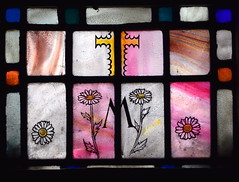 |
|
There are ages of faith
which leave their traces in splendour and beauty,
as acts of piety and memory. East Anglia is full
of silent witnesses to tides which have ebbed and
flowed. Receding, they leave us in their wake
great works from the passing ages, little Norman
churches which seem to speak a language we can no
longer understand but which haunts us still, the
decorated beauty of the 14th Century at odds with
the horrors of its pestilence and loss, the
perpendicular triumph of the 15th Century church
before its near-destruction in the subsequent
Reformation and Commonwealth, the protestant
flowering of chapels and meeting houses in almost
all rural communities, and most obvious of all
for us today the triumphalism of the Victorian
revival.
But even as tides recede, piety and memory
survive, most often in quiet acts and intimate
details. The catholic church of Holy Family and
St Michael at Kesgrave is one of their great 20th
Century treasure houses. |
At the time of the 1851 census of
religious worship, Kesgrave was home to just 86 people,
79 of whom attended morning service that day, giving this
parish the highest percentage attendance of any in
Suffolk. However, they met half a mile up the road at the
Anglican parish church of All Saints, and the current
site of Holy Family was then far out in the fields. In
any case, it is unlikely that any of the non-attenders
was a Catholic. Today, Kesgrave is a sprawling eastern
suburb of Ipswich, home to about 10,000 people. It
extends along the A12 corridor all the way to Martlesham,
which in turn will take you pretty much all the way to
Woodbridge without seeing much more than a field or two
between the houses.
Holy Family was erected in the 1930s, and serves as a
chapel of ease within the parish of Ipswich St Mary.
However, it is still in private ownership, the
responsibility of the Rope family, who, along with the
Jolly family into which they married, owned much of the
land in Kesgrave that was later built on.
The growth of Kesgrave has been so rapid and so extensive
in these last forty years that radical expansions were
required at both this church and at All Saints, as well
as to the next parish church along in the suburbs at
Rushmere St Andrew. All of these projects are
interesting, although externally Holy Family is less
dramatic than its neighbours. It sits neatly in its trim
little churchyard, red-brick and towerless, a harmonious
little building if rather a curious shape, of which more
in a moment. Beside it, the underpass and roundabout
gives it a decidedly urban air. But this is a church of
outstanding interest, as we shall see.
It was good to come back to Kesgrave. As a member of St
Mary's parish I generally attended mass at the parish's
other church, a couple of miles into town, but I had been
here a number of times over the years, either to mass or
just to wander around and sit for a while. These days,
you generally approach the church from around the back,
where you'll find a sprawling car park typical of a
modern Catholic church. To the west of the church are
Lucy House and Philip House, newly built for the work of
the Rope family charities. Between the car park and the
church there there is a tiny, formal graveyard, with
crosses remembering members of the Rope and Jolly
families.
Access to the church is usually through a west door these
days, but if you are fortunate enough to enter through
the original porch on the north side you will have a
foretaste of what is to come, for to left and right are
stunning jewel-like and detailed windows depicting St
Margaret and St Theresa on one side and St Catherine and
the Immaculate Conception on the other. Beside them, a
plaque reveals that the church was built to the memory of
Michael Rope, who was killed in the R101 airship disaster
of 1930.
 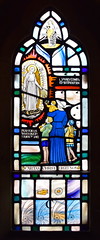 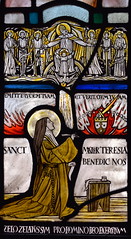  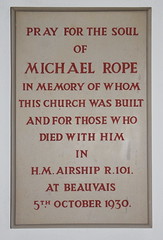
Blue Peter-watching boys like me,
growing up in the 1960s and 1970s, were enthralled by
airships. They were one of those exciting inventions of a
not-so-distant past which were, in a real sense,
futuristic, a part of the 1930s modernist project that
imagined and predicted the way we live now. And they were
just so big. But they were doomed, because the
hydrogen which gave them their buoyancy was explosive.
As a child, I was fascinated by the R101 airship and its
disaster, especially because of that familiar photograph
of its wrecked and burnt-out fuselage sprawled in the
woods on a northern French hillside. It is still a
haunting photograph today. The crash of the R101 put an
end to airship development in the UK for more than half a
century.
Of course, this is all ancient history now, but in the
year 2001 I had the excellent fortune to be shown around
Holy Family by Michael Rope's widow, Mrs Lucy Doreen
Rope, née Jolly, who was still alive, and then in her
nineties. She was responsible for the building of this
church as a memorial to her husband. We paused in the
porch so that I could admire the windows. "Do you
like them?" Mrs Rope asked me. "Of course, my
sister-in-law made them."
Her sister-in-law, of course, was Margaret Agnes Rope,
who in the first half of the twentieth century was one of
the finest of the Arts and Craft Movement stained glass
designers. She studied at Birmingham, and then worked at
the Glass House in Fulham with her cousin, Margaret Edith
Aldrich Rope, whose work is also here. But their work can
be found in churches and cathedrals all over the world.
What Mrs Rope did not tell me, and what I found out
later, is that these two windows in the porch were made
for her and her husband Michael as a wedding present.
Doreen Jolly and Michael Rope were married in 1929.
Within a year, he was dead. Mrs Rope was just 23 years
old.
The original church from the 1930s is the part that you
step into, beneath a tympanum by Ellen Mary Rope, Michael
Rope's aunt, made in the last years of her life. It
depicts the Blessed Virgin cradling a lamb between the
young Christ and St John the Baptist and the inscription Ecce
Agnus Dei, 'behold the Lamb of God'.. You enter to
the bizarre sight of a model of the R101 airship
suspended from the roof. The nave altar and tabernacle
ahead are in the original sanctuary, and you are facing
the liturgical east (actually south) of the original
building, and what an intimate space this must have been
before the church was extended. Red brick outlines the
entrance to the sanctuary, and here are the three windows
made by Margaret Rope for the original church. The first
is the three-light sanctuary window, depicting the
Blessed Virgin and child flanked by St Joseph and St
Michael. Two doves sit on a nest beneath Mary's feet,
while a quizzical sparrow looks on. St Michael has the
face of Michael Rope. The inscription beneath reads Pray
for Michael Rope who gave up his soul to God in the wreck
of His Majesty's Airship R101, Beauvais, October 5th
1930.
 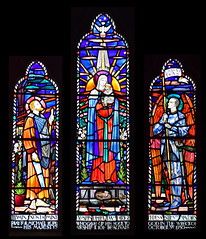 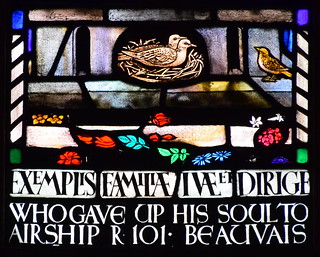
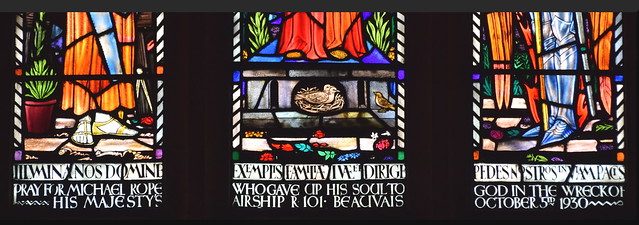
Next, a lancet in the right-hand
side of the sanctuary contains glass depicting St
Dominic. A dog runs with a burning brand beneath his feet
through the inscription Laudare, Benedicere,
Praedicare, ('to praise, to bless, to preach'). The
third window is in the west wall of the church (in its
day, the right hand side of the nave), depicting St
Thomas More and St John Fisher, although at the time the
window was made they had not yet been canonised. The
inscription beneath records that the window was the gift
of a local couple in thankfulness for their
conversion to the faith for which the Blessed Martyrs
Thomas More and John Fisher gave their lives. A rose
bush springs from in front of the martyrs' feet.
 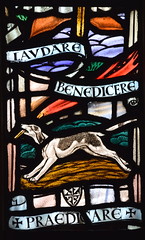 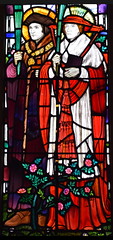
 
By the 1950s, Holy Family was no
longer large enough for the community it served, and it
was greatly expanded to the east to the designs of the
architect Henry Munro Cautley. Cautley was a bluff
Anglican of the old school, the retired former diocesan
architect of St Edmundsbury and Ipswich, but he would
have enjoyed designing a church for such an intimate
faith community, and in fact it was his last major
project before he died in 1959. The original sanctuary
was retained as a blessed sacrament chapel, and the
church was turned ninety degrees to face east for the
first time. The north and south sides of the new church
received three-light Tudor windows in the style most
beloved by Cautley, as seen also at his Ipswich County
Library in Northgate Street, and the former Fosters (now
Lloyds) Bank in central Cambridge.
Although the Rope family had farmed at Blaxhall near
Wickham Market for generations, Margaret Rope herself was
not from Suffolk at all, and nor was she at first a
Catholic. She was born in Shrewsbury in 1882, the
daughter of Henry Rope, a surgeon at Shrewsbury
Infirmary, and a son of the Blaxhall Rope family. The
largest collection of Margaret Rope's glass is in
Shrewsbury Cathedral. When Margaret was 17, her father
died. The family were received into the Catholic church
shortly afterwards. A plaque was placed in the entrance
to Shrewsbury Infirmary to remember her father. When the
hospital was demolished in the 1990s, the plaque was
moved to here, and now sits in the north aisle of the
1950s church. In her early days in London Margaret Rope
designed and made the large east window at Blaxhall
church as a memorial to her grandparents. It features her
younger brother Michael, and is believed to be the only
window that she ever signed.
In her early forties, Margaret Rope took holy orders and
entered the Carmelite Convent at nearby Woodbridge, but
continued to produce her stained glass work until the
community moved to Quidenham in Norfolk, when poor health
and the distances involved proved insurmountable. She
died there in 1953, and so she never saw the expanded
church. Her cartoons, the designs for her windows, are
placed on the walls around Holy Family. Some are for
windows in churches in Scotland and Wales, one for a
window in the English College in Rome. Among them are the
roundels for within the enclosure of Tyburn Convent in
London. "They had to remove the windows there during
the War", said Mrs Rope. "Of course, with me,
you have to ask which war!"
 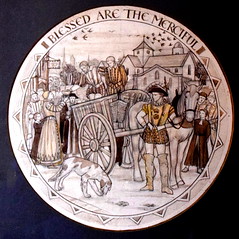 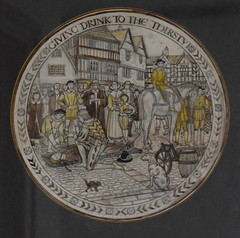
 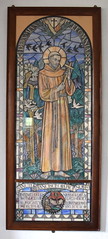 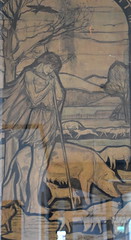   
Turning to the east, we see the new
sanctuary with its high altar, completed in 1993 as part
of a further reordering and expansion, which gave a large
galilee porch, kitchen and toilets to the north side of
the church. The window above the new sanctuary has three
lights, and the two outer windows were made by Margaret
Rope for the chapel of East Bergholt convent to the south
of Ipswich. They remember the Vaughan family, into which
Margaret Rope's sister had married, and in particular one
member, a sister in the convent, to celebrate her 25 year
jubilee. The convent later became Old Hall, a famous
commune. The panels depict the prophet Isaiah and King
David.
The central light between them is controversial. Produced
in the 1990s and depicting the risen Christ, it really
isn't very good, and provides the one jarring note in the
church. It is rather unfortunate that it is in such a
prominent position. It is not just the quality of the
design that is the problem. It lets in too much light in
comparison with the two flanking lights. "The glass
in my sister-in-law's windows is half an inch
thick", Mrs Rope told me. "In the workshop at
Fulham they had a man who came in specially to cut it for
them". The glass in the modern light is simply too
thin.
 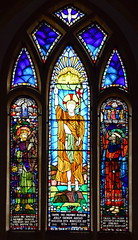 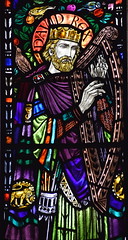  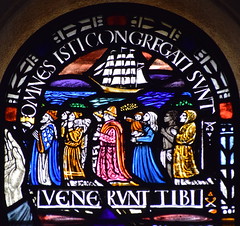
 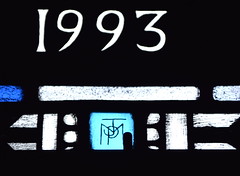 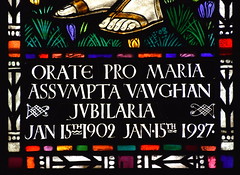
Despite the 1990s extension, and as
so often in modern urban Catholic churches, Holy Family
is already not really big enough, although it is hard to
see that there could ever be another expansion. We walked
along Munro Cautley's south aisle, and at that time the
stations of the cross were simple wooden crosses.
However, about three months after my conversation with
Mrs Rope, the World Trade Centre in New York was attacked
and destroyed, and among the three thousand people killed
were two local Kesgrave brothers who were commemorated
with a new set of stations in cast metal.
Here also is a 1956 memorial window by Margaret Rope's
cousin, Margaret Edith Aldrich Rope, to Mrs Rope's mother
Alice Jolly, depicting the remains of the shrine at
Walsingham and the Jolly family at prayer before it.
Another MEA Rope window is across the church in the
galilee, a Second World War memorial window, originally
on the east side of the first church before Cautley's
extension. It depicts three of the English Martyrs,
Blessed Anne Lynne, Blessed Robert Southwell and Blessed
John Robinson, as well as the shipwreck of Blessed John
Nutter off of Dunwich, with All Saints church on the
cliffs above.
 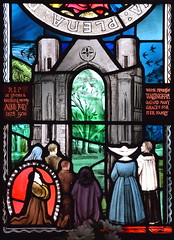 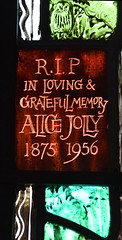 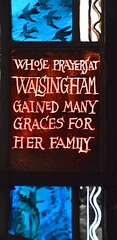
 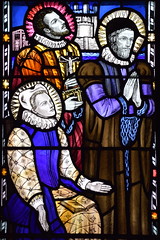 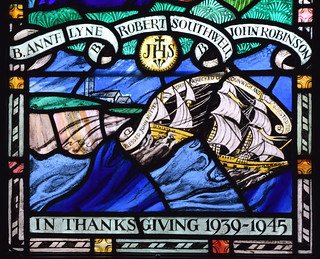 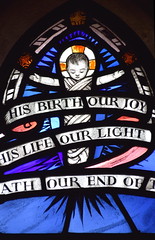
The galilee is designed for
families with young children to play a full part in mass,
and is separated from the church by a glass screen. At
the top of the screen is a small panel by Margaret Rope
which is of particular interest because it depicts her
and her family participating in the Easter vigil,
presumably in Shrewsbury Cathedral. This is hard to
photograph because it is on an internal window between
two rooms.
A recent addition to the Margaret Edith Aldrich Rope
windows here is directly opposite, newly installed on the
south side of the nave. It was donated by her
great-nephew. It depicts a nativity scene, the Holy
Family in the stable at Bethlehem, an angel appearing to
shepherds on the snowy hills beyond. It is perhaps her
loveliest window in the church.
 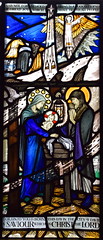 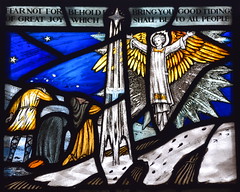
Finally, back across the church.
Here, beside the brass memorial to Henry Rope, is a
window depicting the Blessed Virgin and child, members of
the Rope family in the Candlemas procession beneath. The
inscription reminds us to pray for the soul of Sister
Margaret of the Mother of God, mistress of novices and
stained glass artist, Monastery of the Magnificat of the
Mother of God, Quidenham, Norfolk, entered Carmel 14th
September 1923, died 6th December 1953. Sister
Margaret of the Mother of God was, of course, Margaret
Rope herself. She was buried in the convent at Quidenham,
a Shrewsbury exile at rest in the East Anglian soil of
her forebears.
Margaret Rope had made the main
body of this window herself, as a present for her mother.
After passing into the hands of her sister, the window
was then used as her memorial, the outer panels with the
inscription added by her cousin Margaret Edith Aldrich
Rope. Intriguingly, Margaret Rope's great-nephew Arthur
Rope has suggested to me that her cousin also replaced
the small kneeling figure panel bottom right, which in
Margaret Rope's cartoon for the window depicts a
self-caricature. As he points out, the figure there now
looks very much like the nun kneeling on Margaret Edith
Aldrich Rope's later memorial to Alice Jolly across the
church.
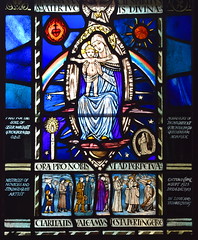 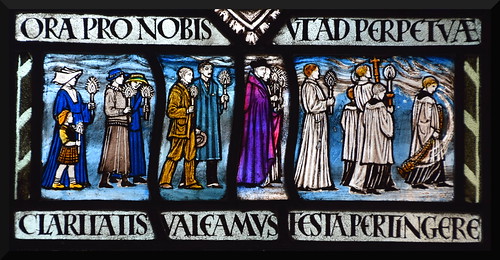
Back in 2001, we were talking about
the changing Church, and I asked Mrs Rope what she
thought about the recently introduced practice of
transferring Holy Days on to the nearest Sunday, so that
the teaching of them was not lost. Mrs Rope approved, a
lady clearly not stuck in the past. She had a passion for
ensuring that the Faith could be shared with children. As
we have seen, her church is designed so that young
families can take a full part in the Mass. But she was
sympathetic to the distractions of the modern age.
"The world is so exciting for children these
days", she said. "I think it must be difficult
to bring them up with a sense of the presence of
God." She smiled. "Mind you, my son is 70 now!
And I do admire young girls today. They have such
spirit!"
And so this grand old lady left me
to potter about in her wonderful treasure house. As I did
so, I thought of medieval churches I have visited, which
were similarly donated by the Mrs Ropes of their day,
perhaps even for husbands who had died young. They not
only sought to memorialise their loved ones, but to
consecrate a space for prayer, that masses might be said
for the souls of the dead. This was the Catholic way, a
Christian duty. Before the Reformation, this was true in
every parish in England. It remained true here at
Kesgrave.
One of the great losses to
the Church of England is the practice of praying
for the souls of the dead, anathematised at the
Reformation, and now encouraged in only a few
Anglican parishes. Prayers for our lost loved
ones bound our communities together, the past
with the present, the living and the dead. Today,
all over the land, many Anglican congregations
are shrinking, and yet on the soft ground around
their churches the locals enact a pagan cult of
the dead, worshipping their recent ancestors with
propitiatory flowers, often unable to combine
this act with a prayer said inside a sacred
building, increasingly unaware that such a thing
might even be appropriate. It seems a shame.
And so, finally, back outside to the small
graveyard of Holy Family. Simple crosses line the
low yew hedging, as if this were a convent
cemetery. Side by side are two particular
crosses. One remembers Margaret Edith Aldrich
Rope, artist, 1891-1988. The other remembers Lucy
Doreen Rope, founder of this church, 1907-2003. |
|
 |
Simon
Knott, April 2018
Follow these journeys as they happen at Last Of England
Twitter.
|
|
|

